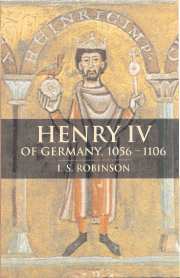Book contents
- frontmatter
- Contents
- Acknowledgements
- INTRODUCTION
- THE YOUNG KING, 1056–1075
- THE CONFLICT WITH POPE GREGORY VII
- EMPEROR HENRY IV, 1084–1106
- 7 The pacification of Germany, 1084–1089
- 8 Henry IV, the imperial Church and the papacy: the third Italian expedition, 1090–1097
- 9 The restoration of royal authority in Germany, 1097–1103
- 10 The end of the reign, 1103–1106
- CONCLUSION
- Bibliography
- Index
10 - The end of the reign, 1103–1106
from EMPEROR HENRY IV, 1084–1106
Published online by Cambridge University Press: 18 July 2009
- frontmatter
- Contents
- Acknowledgements
- INTRODUCTION
- THE YOUNG KING, 1056–1075
- THE CONFLICT WITH POPE GREGORY VII
- EMPEROR HENRY IV, 1084–1106
- 7 The pacification of Germany, 1084–1089
- 8 Henry IV, the imperial Church and the papacy: the third Italian expedition, 1090–1097
- 9 The restoration of royal authority in Germany, 1097–1103
- 10 The end of the reign, 1103–1106
- CONCLUSION
- Bibliography
- Index
Summary
The ‘imperial peace’ of January 1103 committed princes and nobility to cooperation with the emperor in the task of eradicating crimes of violence. Another harmonious scene was enacted six months later, when the rebellious Count Robert II of Flanders was reconciled to the emperor in Liège ‘in a very numerous assembly of princes from the whole kingdom’. A large number of Saxon princes joined the imperial entourage in mid-July. They doubtless came to discuss Saxon affairs: perhaps the implementation of the ‘imperial peace’ in Saxony. ‘Many princes both of the Church and of the kingdom’ were similarly present in Regensburg during the imperial visit of December 1103 – February 1104. It was during this visit to Regensburg that the political harmony that had prevailed during 1103 was disturbed by an act of violence which aroused the keenest interest throughout the kingdom and had serious repercussions for the emperor. On 5 February 1104 Count Sigehard of Burghausen was murdered in Regensburg by ministeriales. Sigehard and his brother, Count Frederick of Tengling, had been present at the assembly of 14 January in Regensburg, which dealt with the grievances of the church of Augsburg. According to the chronicler Ekkehard of Aura, Sigehard became an object of imperial suspicion when he voiced the feeling of the Bavarian princes that ‘the Saxons and Franconians received friendlier and more honourable treatment from the emperor than the natives’.
- Type
- Chapter
- Information
- Henry IV of Germany 1056–1106 , pp. 321 - 344Publisher: Cambridge University PressPrint publication year: 2000



